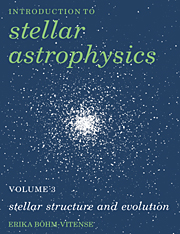Book contents
- Frontmatter
- Contents
- Preface
- 1 Introduction
- 2 Hydrostatic equilibrium
- 3 Thermal equilibrium
- 4 The opacities
- 5 Convective instability
- 6 Theory of convective energy transport
- 7 Depths of the outer convection zones
- 8 Energy generation in stars
- 9 Basic stellar structure equations
- 10 Homologous stars in radiative equilibrium
- 11 Influence of convection zones on stellar structure
- 12 Calculation of stellar models
- 13 Models for main sequence stars
- 14 Evolution of low mass stars
- 15 Evolution of massive stars
- 16 Late stages of stellar evolution
- 17 Observational tests of stellar evolution theory
- 18 Pulsating stars
- 19 The Cepheid mass problem
- 20 Star formation
- Appendix Radiative energy transport in stars
- Problems
- References
- Index
14 - Evolution of low mass stars
Published online by Cambridge University Press: 08 January 2010
- Frontmatter
- Contents
- Preface
- 1 Introduction
- 2 Hydrostatic equilibrium
- 3 Thermal equilibrium
- 4 The opacities
- 5 Convective instability
- 6 Theory of convective energy transport
- 7 Depths of the outer convection zones
- 8 Energy generation in stars
- 9 Basic stellar structure equations
- 10 Homologous stars in radiative equilibrium
- 11 Influence of convection zones on stellar structure
- 12 Calculation of stellar models
- 13 Models for main sequence stars
- 14 Evolution of low mass stars
- 15 Evolution of massive stars
- 16 Late stages of stellar evolution
- 17 Observational tests of stellar evolution theory
- 18 Pulsating stars
- 19 The Cepheid mass problem
- 20 Star formation
- Appendix Radiative energy transport in stars
- Problems
- References
- Index
Summary
Evolution along the subgiant branch
Solar mass stars
From previous discussions we know that solar mass stars last about 1010 years on the main sequence. Lower mass stars last longer. Since the age of globular clusters seems to be around 1.2 × 1010 to 1.7 × 1010 years and the age of the universe does not seem to be much greater, we cannot expect stars with masses much smaller than that of the Sun to have evolved off the main sequence yet. We therefore restrict our discussion to stars with masses greater than about 0.8 solar masses, which we observe for globular cluster stars.
We discussed in Section 10.2 that for a homogeneous increase in μ through an entire star (due to an increase in helium abundance and complete mixing), the star would shrink, become hotter and more luminous. It would evolve to the left of the hydrogen star main sequence towards the main sequence position for stars with increasing helium abundance. In fact, we do not observe star clusters with stars along sequences consistent with such an evolution (except perhaps for the socalled blue stragglers seen in some globular clusters which are now believed to be binaries or merged binaries). Nor do we know any mechanism which would keep an entire star well mixed. We therefore expect that stars become helium rich only in their interiors, remaining hydrogen rich in their envelopes. Since nuclear fusion is most efficient in the center where the temperature is highest, hydrogen depletion proceeds fastest in the center. Hydrogen will therefore be exhausted first in the center.
- Type
- Chapter
- Information
- Introduction to Stellar Astrophysics , pp. 172 - 196Publisher: Cambridge University PressPrint publication year: 1992

